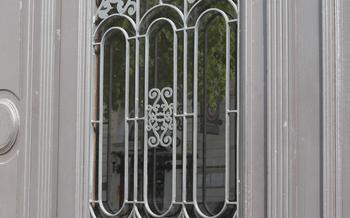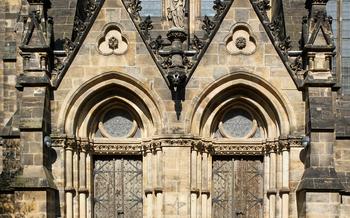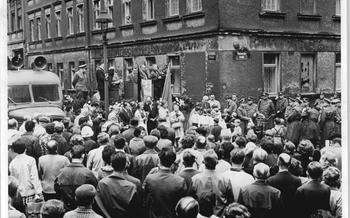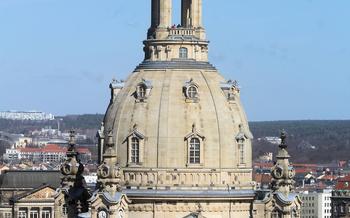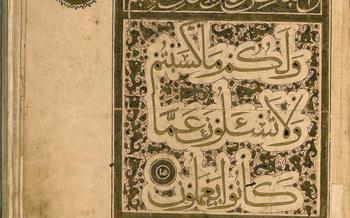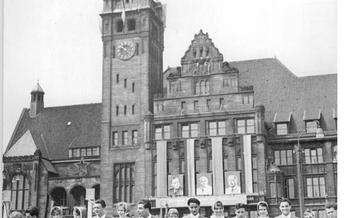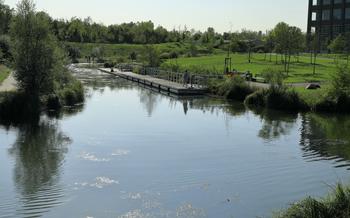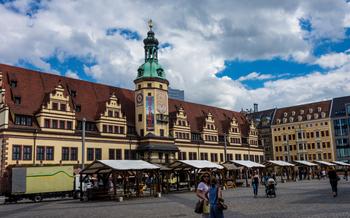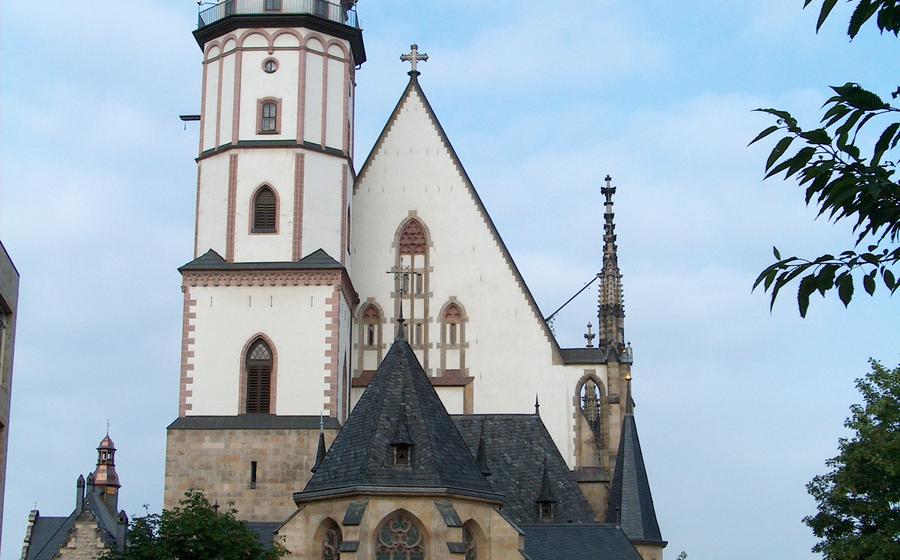
Thomaskirche (St. Thomas Church)
- History of the Thomaskirche: A Journey Through Time
- Architectural Highlights
- The Thomanerchor
- Bach's Legacy
- Guided Tours
- Opening Hours and Admission
- Location and Accessibility
- Concerts and Events
- Music Museum
- Nearby Attractions:
- Photography and Filming
- Accessibility for Disabled Visitors
- Dress Code
- Food and Drink:
- Insider Tip:
History of the Thomaskirche: A Journey Through Time
The Thomaskirche, a majestic edifice in the heart of Leipzig, Germany, holds within its walls a rich tapestry of history, faith, and music. Originally constructed in the 12th century as a Romanesque basilica, the church underwent a transformation in the 13th century, when it was rebuilt in the Gothic style, reflecting the prevailing architectural trends of the period. This reconstruction marked the beginning of a new era for the Thomaskirche, shaping its distinctive appearance that has captivated visitors for centuries.
As the heart of Lutheranism in Leipzig, the Thomaskirche played a pivotal role in the Protestant Reformation. Martin Luther himself preached from its pulpit, leaving an indelible mark on the church's legacy. The Thomaskirche also became renowned as the home of the Thomanerchor, one of the oldest and most celebrated boys' choirs in the world. Founded in the 13th century, the Thomanerchor has graced the church with its exquisite music for generations, contributing to the Thomaskirche's reputation as a center of musical excellence.
Architectural Highlights
The Thomaskirche is a stunning example of Gothic architecture, with its soaring vaults, intricate stained glass windows, and beautiful sculptures. The westwerk, or west facade, is particularly impressive, with its three gables, two towers, and a central rose window. The nave, or main body of the church, is equally impressive, with its tall, slender columns and ribbed vaults. The chancel, or easternmost part of the church, is home to the high altar, which is decorated with a beautiful altarpiece depicting the Last Supper.
Other notable features of the Thomaskirche include the pulpit, which is made of carved wood and features scenes from the life of Jesus, and the baptismal font, which is made of bronze and dates back to the 13th century. The church is also home to a number of impressive works of art, including paintings by Lucas Cranach the Elder and sculptures by Tilman Riemenschneider.
The Thomanerchor
The Thomaskirche is renowned for its association with the Thomanerchor, one of the oldest and most prestigious boys' choirs in the world. Founded in 1212, the choir has a rich history of musical excellence and has played a significant role in the musical life of Leipzig.
The Thomanerchor is composed of approximately 90 boys aged 9 to 18 and is known for its exceptional vocal skills and diverse repertoire. The choir performs regularly in the Thomaskirche, singing during Sunday services, special events, and concerts.
One of the most notable moments in the choir's history was its association with Johann Sebastian Bach, who served as the Thomaskantor, or choirmaster, from 1723 to 1750. Bach composed many of his most famous works for the Thomanerchor, including the St. Matthew Passion and the St. John Passion.
The Thomanerchor continues to be a vital part of the Thomaskirche and the city of Leipzig. Its performances are highly acclaimed and attract music lovers from around the world. Visitors to the Thomaskirche can often hear the choir singing during services or concerts, providing a truly unforgettable musical experience.
Bach's Legacy
Johann Sebastian Bach's tenure as cantor of the Thomaskirche from 1723 to 1750 left an indelible mark on the church and the city of Leipzig. During his time, Bach composed some of his most renowned works, including the St. Matthew Passion, the St. John Passion, and the Christmas Oratorio. These masterpieces, which were often premiered in the Thomaskirche, revolutionized sacred music and continue to be performed and studied by musicians and scholars worldwide.
Bach's compositions for the Thomaskirche are characterized by their intricate counterpoint, expressive melodies, and profound understanding of the human condition. His music brought a new level of artistry and emotional depth to Lutheran worship services, and it helped to establish Leipzig as a major center of musical innovation.
Beyond his compositions, Bach also played a crucial role in shaping the musical life of the Thomaskirche. He introduced new standards of performance and discipline to the Thomanerchor, transforming it into one of the finest boys' choirs in Europe. He also established a series of concerts at the Thomaskirche, which attracted visitors from far and wide and helped to spread his musical influence beyond Leipzig.
Bach's legacy continues to live on at the Thomaskirche. His music is still performed regularly in the church, and the Thomanerchor continues to uphold the high standards of musical excellence that he instilled. Visitors to the Thomaskirche can experience Bach's music firsthand by attending a concert or service, or by visiting the Bach-Archiv Leipzig, a museum dedicated to his life and work.
Guided Tours
The Thomaskirche offers guided tours in various languages, providing visitors with a deeper understanding of the church's history, architecture, and musical heritage. These tours are typically led by knowledgeable guides who share fascinating stories and insights about the church and its significance.
During a guided tour, visitors will explore the church's interior, marveling at its Gothic architecture, intricate stained glass windows, and beautiful sculptures. They will learn about the church's role as a center of Lutheranism and the home of the Thomanerchor, one of the oldest and most renowned boys' choirs in the world.
The guides will also share stories about Johann Sebastian Bach, who served as the church's cantor from 1723 to 1750. Visitors will learn about Bach's profound impact on the Thomaskirche and the city of Leipzig, and they will hear about his compositions for the church, including the St. Matthew Passion and the St. John Passion.
Guided tours of the Thomaskirche typically last for about an hour and are available at various times throughout the day. Visitors can book their tickets in advance online or purchase them at the church's ticket office. There are also discounts available for groups and students.
Opening Hours and Admission
The Thomaskirche is open to visitors from Sunday to Friday, with varying hours depending on the day. On Sundays, the church is open from 12:30 pm to 4:30 pm, while on Mondays, Tuesdays, Thursdays, and Fridays, it is open from 10:00 am to 4:30 pm. On Wednesdays, the church is closed to visitors.
Admission to the Thomaskirche is generally free of charge, although there may be a small fee for guided tours or special events. However, donations are always welcome and help to support the ongoing maintenance and preservation of this historic church.
Location and Accessibility
The Thomaskirche is conveniently located in the heart of Leipzig's city center, making it easily accessible by foot, public transportation, or car. It is situated near major attractions such as the Leipzig Opera and the Gewandhaus concert hall, allowing visitors to combine their visit to the church with other cultural experiences.
To reach the Thomaskirche by public transportation, visitors can take bus lines 8, 10, 11, or 60 and get off at the Thomaskirche stop. Alternatively, tram lines 4, 7, and 12 also stop nearby. For those arriving by car, there are several parking garages in the vicinity, including the Marktgalerie parking garage and the Petersbogen parking garage.
Whether arriving by foot, public transportation, or car, visitors will find the Thomaskirche easy to locate. Its iconic architecture and prominent position in the city center make it a landmark that is hard to miss.
Concerts and Events
The Thomaskirche is not only a historical and architectural gem but also a vibrant center for music and cultural events. Throughout the year, the church hosts a variety of concerts, recitals, and performances that showcase the talents of local and international musicians.
One of the main highlights of the Thomaskirche's concert calendar is the annual Bachfest Leipzig, which takes place in June and celebrates the life and work of Johann Sebastian Bach. During the festival, the Thomaskirche hosts numerous concerts, including performances of Bach's major choral works, such as the St. Matthew Passion and the St. John Passion.
In addition to the Bachfest, the Thomaskirche regularly hosts organ concerts featuring renowned organists from around the world. The church's magnificent Silbermann organ, built in 1721, is one of the finest examples of Baroque organ building and is a popular attraction for music lovers.
The Thomaskirche also hosts regular performances by the Thomanerchor, one of the oldest and most renowned boys' choirs in the world. The choir's repertoire spans centuries of music, from Renaissance polyphony to contemporary compositions, and their performances are always a special treat for music enthusiasts.
To find out more about upcoming concerts and events at the Thomaskirche, visitors can check the church's website or contact the Thomaskirche office. Tickets for concerts can be purchased online or at the door, subject to availability.
Music Museum
The Thomaskirche is also home to the Bach-Archiv Leipzig, a museum dedicated to the life and work of Johann Sebastian Bach. The museum is located in the former school building of the Thomasschule, where Bach taught and composed for over 25 years. Visitors to the museum can learn about Bach's life and career, as well as his influence on music and the Lutheran Church. The museum's collection includes Bach's manuscripts, instruments, and personal belongings, as well as exhibits on his compositions and his family.
The Bach-Archiv Leipzig is a must-visit for any fan of Bach or classical music. The museum offers a fascinating glimpse into the life and work of one of the most influential composers of all time. Visitors can learn about Bach's compositional process, his relationship with the Thomaskirche, and his legacy as a teacher and mentor. The museum also hosts regular concerts and events, including performances of Bach's music by the Thomanerchor.
Nearby Attractions:
In the vicinity of the Thomaskirche, a treasure trove of captivating attractions awaits. The Leipzig Opera, a majestic neo-Renaissance edifice, enchants visitors with its opulent interior and world-class opera performances. The Gewandhaus concert hall, renowned for its exceptional acoustics, hosts prestigious concerts by the Gewandhaus Orchestra, one of the oldest and most celebrated orchestras in the world.
A short stroll from the Thomaskirche leads to the St. Nicholas Church, an architectural marvel that boasts an awe-inspiring Gothic facade and intricate interior decorations. This magnificent church is a testament to the city's rich religious heritage and serves as a popular venue for classical concerts and organ recitals.
To delve deeper into the musical legacy of Leipzig, visitors can explore the Mendelssohn-Haus, a museum dedicated to the life and work of the renowned composer Felix Mendelssohn. This charming house-museum offers a glimpse into Mendelssohn's personal life and creative process, showcasing his manuscripts, instruments, and personal belongings.
For those seeking a unique shopping experience, the Mädlerpassage, an elegant 19th-century arcade, beckons with its array of boutiques, specialty shops, and cafes. This charming passage is a delightful place to browse for souvenirs, gifts, and local delicacies.
Photography and Filming
Photography and filming are generally allowed inside the Thomaskirche, but there are a few rules and regulations that visitors must follow.
- Flash photography is not permitted, as it can damage the church's interior and artworks.
- Tripods and other camera equipment are also not allowed, as they can obstruct the view of other visitors.
- Filming for commercial purposes requires prior permission from the church authorities.
Visitors are encouraged to be respectful of the church's sacred atmosphere and to avoid taking photos or filming during services or concerts.
To capture the best photos of the Thomaskirche, it is recommended to use a wide-angle lens to capture the grandeur of the interior.
For the best lighting conditions, it is advisable to visit the church in the morning or late afternoon, when the natural light is most flattering.
Accessibility for Disabled Visitors
The Thomaskirche is committed to ensuring that all visitors can enjoy their experience, regardless of their abilities. The church is wheelchair accessible, with ramps leading up to the main entrance and elevators to all levels. Accessible restrooms are also available.
Visitors with disabilities can request assistance from the church staff, who are happy to provide directions, information, and any other assistance that may be needed. The staff can also arrange for sign language interpretation or other accommodations upon request.
To ensure the best possible experience, it is recommended that disabled visitors contact the Thomaskirche in advance to discuss their specific needs and arrangements can be made accordingly. The church is dedicated to making sure that everyone can have a meaningful and enjoyable visit.
Tip: If you have any specific accessibility requirements, it is a good idea to contact the Thomaskirche in advance to ensure that all necessary arrangements can be made.
Dress Code
Visiting the Thomaskirche requires a respectful demeanor and attire. While there is no strict dress code, visitors are expected to dress modestly and appropriately for a religious setting. Smart casual attire is generally recommended. Avoid wearing shorts, tank tops, or revealing clothing. It is important to remember that the church is an active place of worship, and visitors should dress in a way that is respectful of the religious services and ceremonies that take place there.
Food and Drink:
After a visit to the Thomaskirche, you may be looking for a place to grab a bite to eat or a drink. The surrounding area offers a variety of dining options to suit every taste and budget. For a quick and casual meal, try one of the many cafes or bakeries in the area, such as the popular Café Kandler or Bäckerei & Konditorei Lehmann. If you're looking for a more substantial meal, there are several restaurants nearby that offer traditional German cuisine, international fare, and vegetarian options. Be sure to try local specialties such as Leipziger Allerlei, a hearty stew made with vegetables, meat, and dumplings, or Leipziger Gose, a sour wheat beer brewed in Leipzig since the 15th century. For a special treat, indulge in a slice of Leipziger Lerche, a marzipan cake shaped like a skylark, which is a symbol of the city.
Insider Tip:
-
If you're a fan of classical music, try to attend a concert or performance at the Thomaskirche. The acoustics in the church are incredible, and it's a truly unforgettable experience to hear Bach's music performed in the المكان الذي كتب فيه وعمل.
-
To avoid the crowds, visit the church early in the morning or late in the afternoon. You'll have the chance to explore the church at your own pace and take some stunning photos without the distraction of other visitors.
